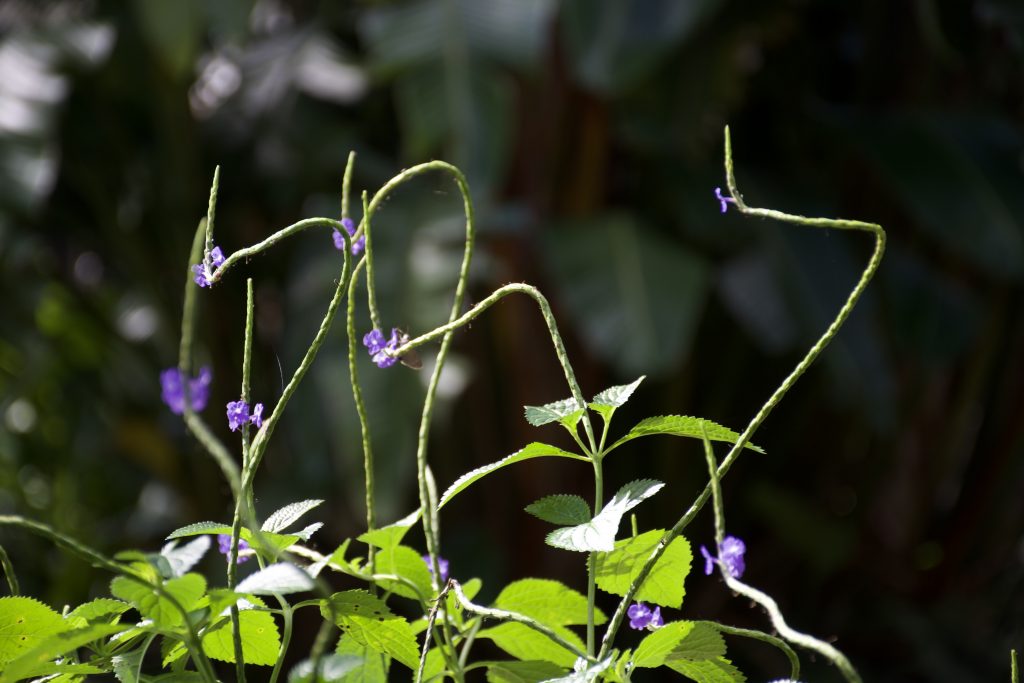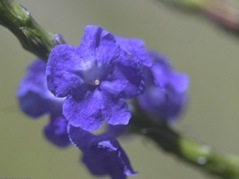
Tall Blue Porter Weed. Photo by Green Deane
Stachytarpheta jamaicensis: Near Beer
Should the civilized world come to an end and you have a hankering for a stout beer you’re in luck: You can make one from the Blue Porterweed, Stachytarpheta jamaicensis. And if a beer is not to your liking, then you can make it into a tea with a beer-like foam.
Porter is a dark brown beer on the bitter side. A stout is a strong porter. Porter’s Beer, Porter’s Ale, Porter House Steaks all go back to shops that serviced porters and laborers in England as early as the early 1700’s. The Central American brew made with the Blue Porterweed got its name by the dark color and bitter flavor of that ancient ale.
The tea side of the Blue Porterweed is better known. It was once exported from Brazil as Brazilian Tea and was also used to stretch “Chinese” tea. In fact it is still used in Brazil today. It is drank for taste or medicinally.
Beer and tea is not the plant’s only claim to fame, besides a long list of herbal uses (see the herb blurb below.) It is a mainstay of almost every butterfly garden. Because of the plant’s growth habit of sending up a spike that then flowers out continuously it is butterfly fast food. Attracted to it are skippers, viceroys, monarchs, and queens, among many.
Stachytarpheta is from the Greek words stachys meaning spike and tarphys which means thick or dense. This is reference to the flower spike. How that is said is a bit of debate. In Latin they say steak-ee-tar-FEE-tuh. In Greek, which is what the words are, the first “A” would be short: stah-ee-tar-FEE-tuh. Jamaicensis means of Jamaica — read Caribbean — and is said jah-may-CEN-sis. At any rate some think it got to Florida around 1700 from Jamaica and then butterfly gardens around the world.
How did they make the beer? No one seems to report that. The way to do it is make a tea of suitable taste and then add sugar and yeast, which is how the soft drink Root Beer started out, as root tea.
I learned from my good friend Ryan (husband of forager Sunny Savage and good friends of mine) that the blossoms taste like mushrooms. And they do! Delicately so. I’ve never found a reference for said but Ryan said they ate them in Hawaii where he grew up. I’ve tried them. Tasty and quite surprising.
A few words of caution: Don’t mistake Vervain, Verbena Officinalis, which has some edible parts, for Blue Porterweed. There is some resemblance but Vervain branches more freely, has plump bloom tips and the leaves are more lance shaped whereas the Blue Porterweed tends to have oval leaves, less branching, and has a long skinny flowering tip that is skinny to the end. Stachytarpheta urticifolia was historically used in Bangladesh to induce abortions. Research with mice in 2004 confirmed that effect.
Green Deane’s “Itemized” Plant Profile
IDENTIFICATION:
A low shrub that trails on the ground, tips rising up, no taller than a yard, usually much less, one or two feet, stems angled, leaves opposite, oval to lance shaped, dark green one to four inches long, edges distinctly toothed. Five petal blue flowers grow on a spike, a few at a time opening only one day. There are several related species: Remember, it is a short plant with blue flowers. If it came from a nursery it is probably NOT the right plant.
TIME OF YEAR:
Year round, spring to fall in more northern climes.
ENVIRONMENT:
Sand dunes to pine forests to scrub land and even occasionally wetlands. Naturalized in Florida, Alabama, Hawaii and Puerto Rico. Found in seasonal flower gardens
METHOD OF PREPARATION:
Dry the leaves, use like Chinese tea, or brew beer, blossoms as a trail side nibble. You can also use the spikes as a flavoring ingredient like a bay leaf.
HERB BLURB
2003 Abstract: The anti-oxidant effects of ethyl acetate (EAcE) and n-hexane extracts (nHE) of dried leaves of Stachytarpheta jamaicensis Vahl. (Verbenaceae) on the reactive oxygen species (ROS) generating during the respiratory burst of rat peritoneal macrophages were investigated. Only EAcE, at concentrations between 0.4 and 40 µg/ml, inhibited the extracellular release of oxygen radicals by resident peritoneal macrophages stimulated with phorbol-12-myristate 13-acetate (PMA). At concentrations above 40 µg/ml, EAcE inhibited the production of nitric oxide (NO) in macrophages stimulated in vivo with sodium thioglycollate then in vitro with lipopolysaccharide (LPS) and gamma-interferon (IFN-). nHE extracts at concentrations between 0.4 and 40 µg/ml did not scavenge O-2 generated enzymatically by hypoxanthine/xanthine oxidase (HX/XO) system, but EAcE at the same concentrations showed potent O-2-scavenging activity. At 40 µg/ml, EAcE also inhibited XO activity. These results suggest that the EAcE extract of S. jamaicensis may be a potential pharmaceutical value in treatment of immunopathological diseases related to oxidative stress.


